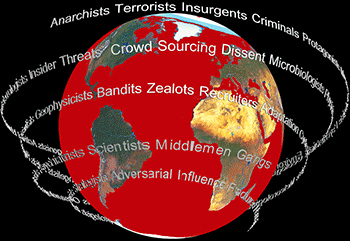Crafty Bastards Workshop - Red Team
"The spread of evil is the symptom of a vacuum. whenever evil wins, it is only by default: by the moral failure of those who evade the fact that there can be no compromise on basic principles. "
~ Ayn Rand ~ 1966
Meet Your NCTC Team
Meet Your KGH Team
Meet Your Colleagues
Current Mission:
The Terrorist Threat: February 25-27, 2015
What is the nature and character of the “global others” that find dislocations in the global rule sets and rise up violently to change them? These violent non-state actors will be assessed across the same factors, highlighting areas where competitions or meaningful balances exist, the salient features of those balances, as well as the relative strengths, weaknesses, and dependencies of each actor through that lens.
Read These First:
Red Workshop Paper 
Red Workshop Objectives
The Structure of Violent Extremist Ideologies
Radicalization Dynamics (A Primer)
Current Workshop Library:
The Jihadi Who Kept Asking Why
This article was written in 2004 and references the 9/11 attacks in the United States and the May 12, 2003 bombings in Riyadh, Saudi Arabia as wake up calls for the brand of terror the Wahhabi element of Islam has created. The article focuses on Mansour Al-Nogaidan, a onetime jihadist, turned reformer, turned outspoken critic of Wahhabism directly and the Saudi royal family indirectly. He is a former radical imam who has been imprisoned for his views, writes a column for one of the largest dailies in the Kingdom, makes media appearances and, most importantly, continues to vocally question the ideology of Wahhabism that he contends will lead to the downfall of the royal family.
This article examines why the majority of terrorist incidents over the past several decades have been caused by Muslims. The author addresses the usually cited causes of poverty, religion, male sexual frustration, etc. and dismisses all of them. He asserts that the frustration and humiliation that Muslims now feel is a result of Christians holding the majority of wealth and military might while being the minority population. The frustration and humiliation is rooted in politics rather than sex and in modern experience rather than deep history. And it has little to do with the Koran. The author then goes on to flip the dynamic in the future with Muslims holding more global power and Christians on the decline. He ponders whether they would resort to terrorism as well if their world order were shaken.
Many times, Blue interprets threats based upon previous conflicts. By viewing radical Islamism, and the conflict with Red extremists this way, Blue’s insight into the overall challenge is incomplete. Namely, Blue simplifies and relates Islamic extremism to state-based enemies (e.g. Nazi Germany, Cold War Russia), where the goals of the opposition are ideological rather than economic, geographic, or political. Moreover, these Red actors exist in a culture that is relevantly different from many of the Western Blue actors; their goals are different and, in large part, their motivation is born out of an opposition to Western ideals. Therefore, in Blue’s attempt to subdue Red, traditional “victory” (liberation and/or assimilation of the enemy and their ‘oppressed citizens’ into Blue’s way of life) may serve only to create new enemies. It is crucial to understand the existential values and tribal tensions of a state before attempting to impose new ideals, even if the perception is that the end result will better the state’s people. Anna Simons’ article shows how Blue sets itself up for existential failure in the battle against radical Islam; specifically, by ignoring existing tensions (which could otherwise have been manipulated to preclude creating new enemies), and assuming that American values would be viewed as “better” than existing Islamic values. In short, Blue cannot simply engage in conflict with Red without understanding Red’s environment.
Anna Simons’ follow-up article suggests that the war on terror will be a long war, since “nativists” will react to Westernization with the perception that Blue seeks to destroy the Islamic identity. The article suggests that the struggle with any group whose source of tension is faith-based (as opposed to ideological) is in the inability to challenge that group’s values without creating an existential threat. Theology cannot be “disproven” in the way that state-based ideologies can; rather, opposing these value systems creates the appearance of an oppressive and authoritarian threat. Historically, groups faced with authoritarian threats either recoil into nomadism or oppose that threat by fighting. This is critical when evaluating Red, the drivers of Red, and the way Red spreads its message in opposition to Blue.
"Unless the United States and its allies formulate a comprehensive response to terrorism, better balanced across a range of policy instruments, the results will be increasing international instability and long-term failure.” This was Audrey Kurth Cronin's assessment in International Security in 2003 as she deftly looked at the terrorist backlash to the unintended negative consequences of globalization on the Middle East. This was a novel thought at the time that still resonates today and is gaining traction with the driving ideology of groups such as ISIS, NS and Boko Haram. Cronin argued that the U.S. response to the growing terrorist threat had been “reactive and anachronistic,” relying on a state-centric strategy to tackle an essentially non-state phenomenon (mainly al Qaida). Cronin warned against employing only military power (prescient in her analysis) to achieve fast results and recommended instead a forward-looking strategy based on deliberate responses and statecraft. Her ideas over a decade ago caused much discussion among Warfighter and Intelligence professionals, yet we now see that her writing was prophetic. This tracks with the Workshop series aimed at widening the aperture of terrorism responses and identifying more effective statecraft tools for the USG such as expanding authorities and financial sanctions levied by the Departments of Treasury and State.
In the article, the author writes about the atrocious attacks and increasing level of violence perpetrated by groups like Boko Haram, the Lord’s Resistance Army, and Los Zetas. The author argues that these groups have little do with the perpetrators’ identities (as Nigerians or Africans), but rather stems from society’s culpability in failing to halt the allure of these menacing acts as a form of power. Simons also asserts that Americans play a part in this cycle as well, glorifying menace in mainstream culture and profiteering on the social status it holds in the entertainment industry. American youth culture is then marketed abroad, selling what she calls the “exhilaration we humans can experience…from fighting for or against something bigger and more powerful than ourselves.” Simons says that this is not a uniquely male problem in that young women help to encourage the competition among the young men and that what they “want in a male is someone who can take charge.” Ultimately she says that we must recognize the trend and curtail the glamorization of violence.
In his article “A war best served cold,” Nicholas Thompson makes a parallel between George Kennan’s article in the July 1947 issue of Foreign Affairs to current interpretation of foreign policy strategy with regard to the fight against Al Qaeda. Thompson says that at the time of the publication of Kennan’s article, which introduced the term “containment” in America’s Cold War foreign policy, Harry Truman did not follow the recommendations Kennan actually made, nor did any president following him. Instead, the article’s influence resulted in a misunderstanding of Kennan’s intentions about containment being primarily a political strategy rather than a military strategy. Kennan was opposed to the intervention of American forces in countries where the Soviets were gaining a foothold, like in Greece, Iran, and Turkey. Thompson believes that Kennan’s insight on a long-term, political strategy over a military strategy makes sense today when applied to the struggle against Al Qaeda. Thompson says that we should focus more on spending money to build up the capacity of America’s Muslim allies (in terms of health, education and democracy promotion) rather than the strong offensive strategy that has been applied to fighting Al Qaeda thus far. Furthermore, Kennan believed that America gives strength to the propaganda of its opponents when it fails to act in ways befitting of its ideals. It is in this way that Kennan’s political interpretation of containment could be applied to 21st century foes and supports many of the outcomes of the Blue Workshop.
Why the United States can do very little to alter the course of events in the Middle East right now. The 9/11 attacks gave the misleading impression that the rise of Islamist extremism was “about” the West and required the West to fight a war on terror in order to defeat it. But Islamist extremism is about Islam and about the regimes that rule in the name of the faith; it is hard to imagine the extremist narrative losing its appeal unless and until Arab regimes gain real legitimacy in the eyes of their own citizens. Alternatively, the very act of setting up a quasi state, as the Islamic State has done, may expose the jihadi ideology to expectations of effectiveness it cannot possibly satisfy, so that the radical vision will collapse of its own contradictions, as communism eventually did. There is a great deal that the West can, must, and will do to defend itself from the terrible consequence of this struggle inside another civilization. If in fact we are facing a civilizational war inside someone else’s civilization, then many of the tools we used during the Cold War will prove unavailing. Anything outside actors can do to fortify the legitimacy of Arab states — in the eyes, that is, of their own citizens — will help tip the scales in the war inside Islam. This includes economic assistance aimed at improving education or public health, or at increasing entrepreneurship, or at providing jobs for young people. So, yes, it will be a long war — not between “us” and “them,” but inside the Islamic world. Americans will have to learn to contain an enemy that they can neither destroy nor convert. And that will be a great national test.
Debating Constitutional Order
TERROR AND CONSENT, The Wars for the Twenty-First Century
Reflections on Sovereignty
Fighting Identity Military Review
21st Century Cultures of War: Advantage Them
What ISIS Really Wants
What The Atlantic Left Out About ISIS According To Their Own Expert
What the Atlantic Gets Dangerously Wrong about ISIS and Islam
The War between ISIS and al-Qaeda for Supremacy of the Global Jihadist Movement
On being a Terrorist - Lost In Syria
Review of Bin Laden's Legacy: Why We're Still Losing the War on Terror
Trapped in the War on Terror
Rationality Wars and the War on Terror: Explaining Terrorism and Social Unrest
Increasing tolerance for violence across the Globe:
Tribes—The First and Forever Form
Today's Wars Are Less About Ideas Than Extreme Tribalism
21st Century Tribes
The Clash of Civilizations
How The Sunni-Shiite Divide Cleaves The Middle East
The Kingdom of Silence
The Philosopher of Islamic Terror
 KGH Capability Statement
KGH Capability Statement
